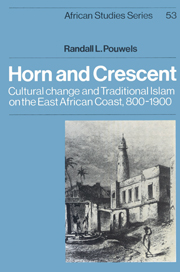Book contents
- Frontmatter
- Contents
- List of illustrations and maps
- Preface
- List of abbreviations
- Introduction
- 1 The roots of a tradition, 800–1500
- 2 The emergence of a tradition, 900–1500
- 3 A northern metamorphosis, 1500–1800
- 4 Town Islam and the umma ideal
- 5 Wealth, piety, justice, and learning
- 6 The Zanzibar Sultanate, 1812–88
- 7 New secularism and bureaucratic centralization
- 8 A new literacy
- 9 The early colonial era, 1885–1914
- 10 Currents of popularism and eddies of reform
- Notes
- Glossary
- Bibliography
- Index
8 - A new literacy
Published online by Cambridge University Press: 23 September 2009
- Frontmatter
- Contents
- List of illustrations and maps
- Preface
- List of abbreviations
- Introduction
- 1 The roots of a tradition, 800–1500
- 2 The emergence of a tradition, 900–1500
- 3 A northern metamorphosis, 1500–1800
- 4 Town Islam and the umma ideal
- 5 Wealth, piety, justice, and learning
- 6 The Zanzibar Sultanate, 1812–88
- 7 New secularism and bureaucratic centralization
- 8 A new literacy
- 9 The early colonial era, 1885–1914
- 10 Currents of popularism and eddies of reform
- Notes
- Glossary
- Bibliography
- Index
Summary
The secularity of the Sultanate, the increasing availability of religious texts, the appearance of new ʿulamaʾ from other parts of the coast and from abroad, and the new contacts established from expanding trade opened up coastal towns to changing religious perceptions. Religion became less parochial in the nineteenth century; Islamic perceptions and practices became less reflective of the individual town.
The impact of religious beliefs produced by such an opening up of society has been studied by Professor Monica Wilson, and her observations seem especially appropriate to the situation of the nineteenth-century coast. In general, the phenomena which Wilson considers to be characteristic of societies experiencing such an expansion include problems of accommodating a local judiciary to the needs and claims of immigrant strangers, an increased specialization of local productive forces and an ensuing secularization of society, and a gradual abandonment of locality spirits and a growing monotheism.
Concerning the first point, Wilson shows the problems frequently encountered by local judges in introducing testimonies of strangers into courts and the consequent difficulties of forming legal opinions on the basis of evidence so provided. When viewed in such a context, one easily can imagine how towns like Mombasa, Zanzibar, and Lamu in the nineteenth century would have required less localized bases for qadis to make judgements in cases involving immigrant strangers. Such qadis would have needed access to legal source materials which had a wider cultural and historical scope than would have been present in most coastal towns previously.
- Type
- Chapter
- Information
- Horn and CrescentCultural Change and Traditional Islam on the East African Coast, 800–1900, pp. 145 - 162Publisher: Cambridge University PressPrint publication year: 1987



